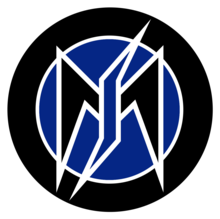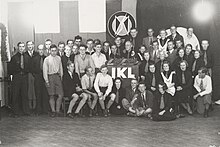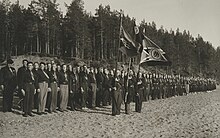Blue-and-Blacks

The Blue-and-Blacks (Sinimustat) was a
History

The Blue-and-Blacks was founded in the winter of 1930–1931, when the students of Lapua Co-educational School founded the Blue-and-Blacks Club in their school, inspired by the ideas of the Lapua movement. Its first chairman was Aulis Ojajärvi and its secretary was Jouko Sinisalo. The Blue-and-Blacks serve as the youth organization of the Lapua movement. The organization had no contacts with the student unions and did not take a position on the language issue.[1]
The Lapua movement ceased operations in the winter of 1932 and the need for a youth organization was soon recognized in IKL, and a ready-made organization for it existed. In January 1933, Blue-and-Blacks became affiliated with the IKL. At that time, the central management of the organization moved to Helsinki and was headed by Pastor Elias Simojoki.
The Blue-and-Blacks and IKL had no official relationship. However, the local director of IKL had to be consulted when electing the head of the local Blue-and-Blacks chapter, and both organizations were headed by the same people, incl. two IKL MPs, Simojoki and Reino Ala-Kulju.
According to the rules of the fall of 1933, the Blue-and-Blacks could be joined by any girl or boy who turned 10 years old. All Blue-and-Blacks wore a uniform organizational suit, a black blouse, and a blue tie. The blacks also used the Roman salute.[3] Every 17-year-old Blue-and-Blacks could join IKL's local branch. The purpose of the organization was to create Greater Finland. In order to achieve this, measures had to be taken to awaken and strengthen the patriotic and Finnish national spirit among Finnish youth. The ideology was especially influenced by the Academic Karelia Society. According to the fascist Ajan Suunta magazine: "Greater Finland, whose border is far away and the people strong - that is the brave goal of the Blue-and-Blacks." In all their activities, the Blue-and-Blacks had to observe Christian moral discipline and order.[1]
Each Blue-and-black was strictly ordered to join the
The new youth organization immediately gained great popularity among school youth. There were seventy Blue-and-Blacks chapters in operation in 1935. There were about 5,500 members who took the oath, but according to Simojoki, its ideas were supported by tens of thousands of young people. The school board, for its part, banned organization uniforms even before the school began in the fall of 1933.[1]
Organizational culture

The Blue-and-Blacks spirit was created by large summer camps held in 1933 in
Members of the organization often behaved fanatically, even in legal gray area. In 1935, the Blue-and-Blacks detonated a homemade tear gas bomb at Vallila's workers' house, and in July the peace meeting in Balder Hall was disrupted by throwing a stink bomb at the audience. In 1935, Blue-and-Blacks took part in street battles against "Hurris" on Swedish Day.
Abolition
The doom of the organisation was getting tangled in the power struggle in Estonia. The Finns - including Simojoki - helped
After the ban
The activities of the blacks were resumed immediately under a new name. IKL's new youth organisation was the "Blackshirts", which published its own magazine "Luo Lippujen", edited by Viljo Lius. The same people came to lead the organization as before: Simojoki, Reino Ala-Kulju,
References
- ^ a b c d e f Mikko Uola: Sinimusta veljeskunta – Isänmaallinen kansanliike 1932–1944. Otava, 1982. ISBN 951-1-06982-9. , osa VIII: Sinimustat ja mustapaidat, pages 292–313
- ^ Jugend und ihre Sprache. Berlin, New York: DE GRUYTER. ISBN 978-3-11-086255-3. Teoksen verkkoversio (viitattu 3.1.2020).
- ^ Suomen Historian Aikakirja, s. 123
- ^ Sinimusta-järjestön katselmus Kuortaneella www.finna.fi. Viitattu 3.1.2020.
- ^ Eepos, Suomen historian käsikirja, Torsten Edgren, Merja Manninen ja Jari Ukkonen, WSOY, ISBN 951-0-27651-0. s. 329-330: IKL - lapuanliikkeen jatkaja, ja s. 348 Äärioikeisto menettää kannatustaan
